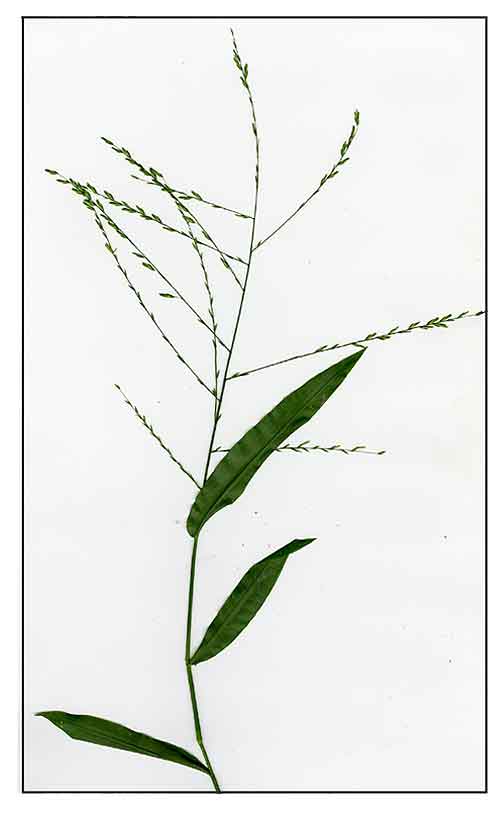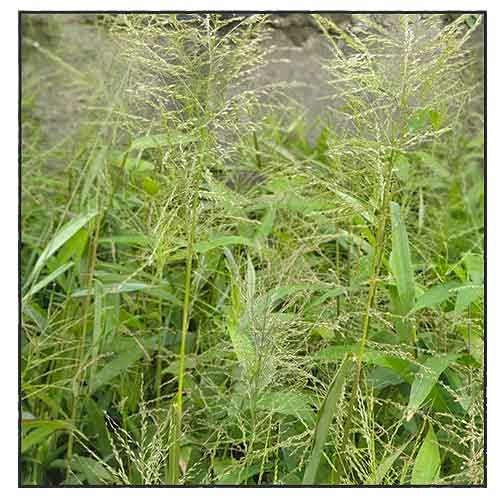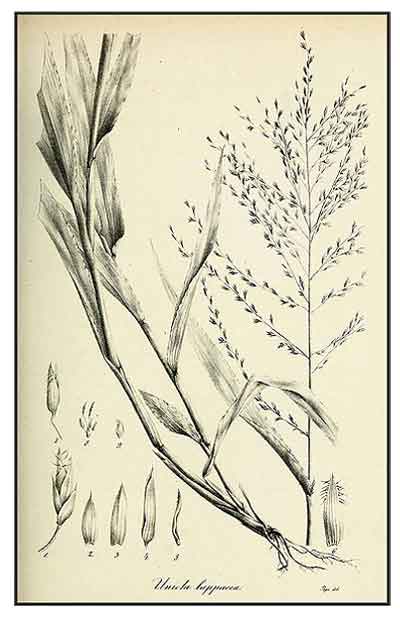
Family • Poaceae
Liliyas
Lil-iyas
Centotheca lappacea (L.) Desvaux
PHILIPPINE SANDBUR GRASS / BARBED GRASS
Jia dan zhu ye
| Scientific names | Common names |
| Andropogon latifolius (Osbeck) Kunth | Liliyas (Bontoc) |
| Anthoxanthum pulchellum D.Dietr. | Lil-iyas (Bontoc) |
| Anthoxanthum pulcherrimum Lour. | Barbed grass (Engl.) |
| Cenchrus lappaceus L. | Common centotheca (Engl.) |
| Centotheca lappacea (L.) Desv. | Philippine sandbur grass (Engl.) |
| Centotheca lappacea var. inermis Rendle | |
| Centotheca lappacea subsp. inermis (Rendle) T.Koyama | |
| Centotheca lappacea var. longilamina (Ohwi) Bor | |
| Centotheca latifolia Trin. | |
| Centotheca latifolia var. inermis (Rendle) Sasaki | |
| Centotheca longilamina Ohwi | |
| Centotheca parviflora Andersson | |
| Cynosurus ciliaris Raspail | |
| Festuca blepharophora Roem. & Schult. | |
| Festuca ciliaris B.Heyne ex Roem. & Schult. | |
| Festuca virgata B.Heyne ex Steud. | |
| Hierochloe latifolia (Osbeck) Kunth | |
| Holcus latifolius Osbeck | |
| Melica diandra Roxb. | |
| Melica lappacea (L.) Raspail | |
| Melica philippensis Llanos | |
| Melica refracta Roxb. | |
| Oplismenus magellanicus (Lam.) Roem. & Schult. | |
| Panicum festuciforme Hochst. ex Hook.f. | |
| Panicum magellanicum Lam. | |
| Poa latifolia (Osbeck) G.Forst. | |
| Torresia biflora Roem. & Schult. | |
| Torresia latifolia (Osbeck) P.Beauv. ex Roem. & Schult. | |
| Uniola lappacea (L.) Trin. | |
| Centotheca lappacea is an accepted species. KEW: Plants of the World Online | |
| Other vernacular names |
| CHINA : Jia dan zhu ye. |
| HMONG: Ya-li-phea. |
| INDONESIA: Jukut kidang, Suket lorodan, Rumput lilit kain. |
| MALAYSIA: Rumput darah, Rumput lilit kain. |
| SIERRA LEONE: Nolomirjkode-na, Kulagbi, Naragbadi, Manding-mandinka. |
| TAHITI: 'Ohe'ohe, Piripiri, Mou'a, Ofe'ofe. |
| THAILAND: Hee yum, Ya repair, Ya hee yoom. |
• Growth form: An erect, perennial grass growing up to 0.3 - 1 m tall. Foliage: Leaves are linear to lanceolate, reaching 5 - 21 cm long and 10 - 35 mm wide. The leaf blades are smooth or pilose (covered in long hairs) with an asymmetrical base that tapers towards the midrib. The leaves are arranged alternately along the stem or culms. Stems: Culms (aboveground stems of grasses and grass-like monocots) are thin and wispy, up to 0.3 - 1 m. Flowers: Flowers are known as florets and consist of heavily reduced petals and sepals, anthers, and stigmas. 2-4 florets are clustered together, forming a spikelet, and arranged along the stem; this inflorescence is known as a panicle, growing up to 25 cm long. Fruit: Fruit is an ellipsoidal caryopsis (a type of dry, indehiscent fruit, commonly known as a grain) up to 1 mm long. The backwards-bending bristles on the lemma attract themselves to the fur of animals and to clothing. (Flora & Fauna Web)
Constituents Properties Studies Availability |
August 2025
![]()
 |
| Â Â Â Â Â Â Â Â Â Â Â Â Â Â Â Â Â Â Â Â Â Â Â Â Â PHOTOS / ILLUSTRATIONS |
| IMAGE SOURCE: Barbed grass / © huamixinhua / PictureThis / Non-commercial use / Image modified / Click on image or link to go to source page / PictureThis |
| OTHER IMAGE SOURCE: Centotheca lappacea / Carl Bernhard von Trinius Hurst / Plant Illustrations.org / Public Domain / Wikipedia |
| OTHER IMAGE SOURCE: Centotheca lappaceae / Maria Vorontsova / Non-commercial use / CC BY 2.0 / LiClick on photo or link to go to source page / flickr / KnowYourWeeds |
| OTHER IMAGE SOURCE: Centotheca lappaceae / © Chop Ching Hin / Non-commercial use / Click on photo or link to go to source page / ChopChingHin |
Additional
Sources and Suggested Readings |
• |
DOI: It is not uncommon for links on studies/sources to change. Copying and pasting the information on the search window or using the DOI (if available) will often redirect to the new link page. (Citing and Using a (DOI) Digital Object Identifier) |
| Â Â Â Â Â Â Â Â Â Â Â Â Â Â Â Â Â Â Â Â Â Â Â Â Â Â Â Â Â Â List of Understudied Philippine Medicinal Plants |
| Â Â Â Â Â Â Â Â Â Â Â Â Â Â Â Â Â Â Â Â Â New plant names needed The compilation now numbers over 1,500 medicinal plants. While I believe there are hundreds more that can be added to the collection, they are becoming more difficult to find. If you have a plant to suggest for inclusion, native or introduced, please email the info: scientific name (most helpful), local plant name (if known), any known folkloric medicinal use, and, if possible, a photo. Your help will be greatly appreciated. |
• |
 |




 analysis revealed volatile constituents after burning it, smoke constituents used in Thai traditional medicine. Nineteen and 25 compounds were found from the roots and aerial parts, respectively. (
analysis revealed volatile constituents after burning it, smoke constituents used in Thai traditional medicine. Nineteen and 25 compounds were found from the roots and aerial parts, respectively. (